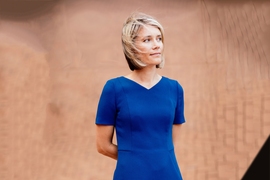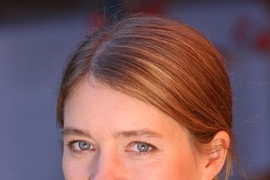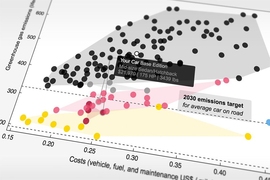Jessika Trancik’s life has been one of straddling languages and cultures, both in academia and in her own life.
Born in Boston to a Swedish mother and American father, she lived in Cambridge as a child but spent summers in Sweden and grew up bilingual, and still carries dual citizenship. In her work as an associate professor in MIT’s Institute for Data, Systems and Society, which spans all of MIT’s five schools, she brings together engineering and the social sciences in order to carry out rigorous analyses of the factors that bring about technological changes that transform society.
Trancik says that “growing up in a couple of different cultures, you become very comfortable with that, and to some extent being able to understand and talk to people from different disciplines is [a similar experience].” And, she says, “science is a way to connect with people around the world. There are no national boundaries; it’s like a more unified network of people working on problems and discussing them.”
“I was always drawn to science and engineering because it affords an opportunity to have a positive impact on people and the planet,” she says.
Trancik graduated from Cornell University, where her father was a professor of urban design and her mother was a lecturer in Swedish. While there she studied materials science, analyzing the structure of metals and ceramics using transmission electron microscopy. In graduate school, as a Rhodes Scholar at Oxford University, she focused on polymer materials including spider silk. This exceptionally strong material, which is formed at room temperature, is a promising model for synthetic materials for structural and other applications, she says. “There’s an environmental motivation there, which is that you can produce a higher-performance material at lower energetic costs,” she says.
At MIT, where she earned tenure last year, Trancik’s work focuses on the pace of innovation in different sectors of technology, and the forces that accelerate or retard that progress, for example in energy storage or in photovoltaic cells. That includes “evaluating opportunities for cost reduction and improvement, and what the effective drivers of improvement might be,” she says.
Her work these days focuses on “whether we can predict in advance what kinds of technological innovations will take off,” and how to influence that process, she says. “This whole area of research that I’ve been working on developing spans evaluating technologies in a larger context — their scalability, their costs, their emissions, their performance along different dimensions — and then using that information to inform how we’re developing these technologies.” The work aims to guide decisions by engineers, policymakers, businesses, and investors.
She credits some early teachers for asking open-ended questions that helped spur creative thinking. “I’ve always had an interest and enjoyment in problem solving and answering previously unanswered questions, and in rigorous ways, in testable ways.” And in applying that, she says, “I was really interested in the environment and in design, and so materials science seemed to bring together a lot of these different topics and questions.”
Trancik’s interests were, and are, quite varied indeed. “Growing up I was very interested in languages, I was very interested in design and painting and drawing, and I was also very interested in math and science, and writing. I did a ton of sports, first gymnastics and then tennis and skiing. That really sort of persisted, along with mountain biking, surfing, and lots of other sports like that. And music as well. I played the saxophone.”
As she grew older, she realized she needed to specialize a bit, she says. “But I would have liked to have continued to do everything.” Still, she comes close. “I’m still skiing, backcountry skiing, surfing, mountain biking, these are my favorite sports. And that’s sort of just a part of my life, like brushing my teeth.”
Before her PhD, Trancik spent a summer doing volunteer work in Kenya, and then following her PhD she worked for a couple of years at the United Nations on postconflict sustainable development. “That’s the time when I got interested in taking my research in a new direction, to span studying technology and materials development as well as big societal challenges. And that’s when I started working on energy and climate change,” she recalls. That led to a fellowship at Columbia University’s Earth Institute, where “the research I was doing was on photovoltaic devices and materials, as well as studying trends in solar energy development, and trying to understand why some technologies develop more quickly than others."
After that, she went to a fellowship at the Santa Fe Institute, where “that afforded me a great opportunity to interact with scientists from many different areas — physicists, economists, biologists, engineers, and so forth.”
There, “the environment really supported what I was trying to do, which was to continue to build this research focus that spanned technology evaluation and technology development, and to explain technological progress in a way that we can help inform and direct it in positive directions,” she says.
Last year, Trancik gave a TEDx talk that summarized her views and her research focus. She says that in addressing global issues like climate change “we want to develop technology to help us solve these challenges. We need to understand how to measure technological progress toward these goals that we care about. And we also need to be able to understand and take advantage of the drivers of technological progress.
“We always have limited time and money,” she says. “So how do we make decisions that are going to allow us to get in the direction that we need to? How do we speed up the process?” That’s what Trancik aims to find out.











